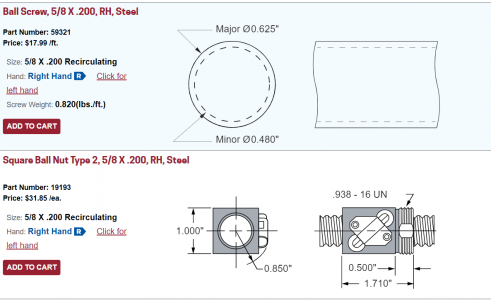- Joined
- Feb 24, 2019
- Messages
- 946
Looking around at Thomson ball screws, it looks like a 5/8 x .200 is available. On the page I was looking it seems the only housing available for the ball nut is square. I'd prefer a round housing but if that's all I get then I'd find a way to make it work.Rockord's finest lead is .125" and that is on a 3/8" shaft. 10 tpi would be difficult to accomplish on a lathe lead screw as the balls would be tiny and not capable of carrying the load. I would suggest that the OP look at a larger lead, e.g., .20" or .25" and use appropriate gearing or software division to to achieve his goals.
My Tormach mill commands steps and assumes that the commands are received and executed properly. Backlash is controlled by mechanical means but still exists. It is on the order of .001" and there is software compensation available. A better option would be to have a separate and independent linear encoder system which controls motion. This would in theory limit backlash to the resolution of the linear scale resolution.
Tormach uses a term called "lost motion" which in addition to free play, also includes things like windup of the lead screw under load. Adjustments like increasing thrust bearing preload can actually increase the lost motion. Increasing cutting load will also increase lost motion. An example of this is the spring pass commonly used when turning on the lathe. A small diameter ball screw will be more prone to twisting due to load induced torque.
The .200 pitch is ideal in this situation, for me, because I'm not going to try for anything extreme and I could easily set my stepper driver for half step and get .005 per step.
One of the things that blew my mind was a standard ball nut for the 5/8 x .200 was around $40. The heavy duty one was well over $400. It's just a longer ball nut with more balls inside.
Thinking about it, I have to check. I might actually have a 5/8 x .200 ball nut. If I do, it has a shaft that's way too short for this application so I'd just need a new shaft.


